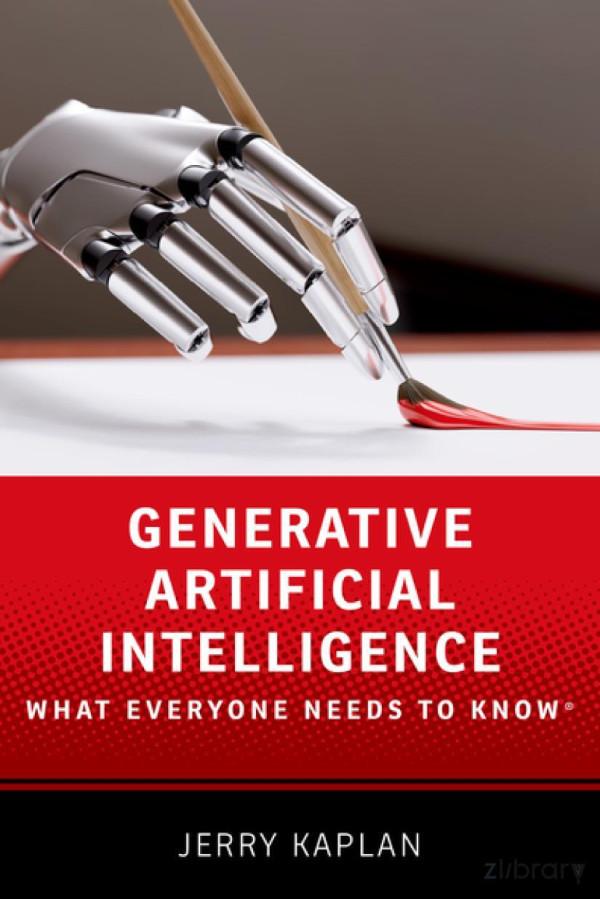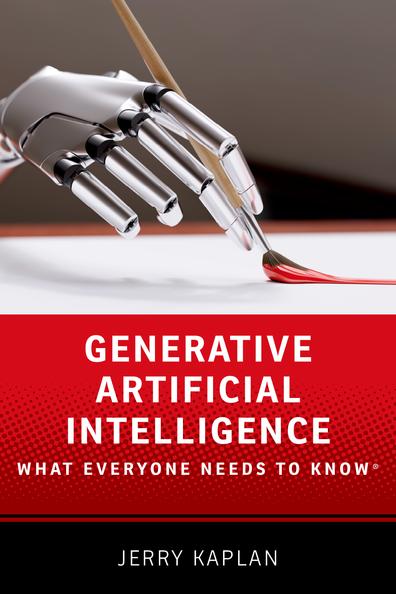INTRODUCTION
Over the past few years, rapid advances in Machine Learning have created a new sub-feld of Artifcial Intelligence: Generative AI. These programs produce novel text, images, music, and software by analyzing enormous collections of digitized material. (Throughout this book, as a shorthand, I will refer to such programs as “GAIs”.)
But this bland description doesn’t begin to do justice to these remarkable polymaths.
The frst wave of GAIs are primarily focused on engaging in natural language conversation. Called “Large Language Models” (LLMs), they already exhibit astonishing profciency on a wide variety of tasks with superhuman performance—as well as a disturbing inclination for falsehood, illogic, and expressions of ersatz emotion, such as declaring their love for interlocutors. They chat with users in plain language and solve a broad range of complex problems with ease. Soon, LLMs will provide expert medical care, dispense legal advice, draft our documents, tutor our children, offer advice, conduct therapy, write computer programs, and manage our organizations and infrastructure. A related class of GAIs generate visual images from simple descriptions that are virtually indistinguishable from human artwork or photographs. Still other applications fabricate voices or compose music in the style of a given artist or musician. Perhaps the most intriguing of these programs are called multimodal, because they integrate diverse forms of information (linguistic, visual, sound, etc.) to understand and reason about the world. (As a demonstration, a prototype multimodal system was able to plan a meal based on a picture of the interior of a refrigerator.)
But this is just the start of the GAI revolution. The technology underlying GAIs is quite general, in the sense that these programs are
capable of learning from any collection of data that can be gathered and prepared for processing—a relatively straightforward task in the modern digital world. And properly confgured and authorized, they will be able to take action on our behalf.
Future versions of this technology will serve as trusted personal assistants. They will take notes for us, act as our representatives in a wide variety of forums, promote our interests, manage our communications, and alert us to imminent dangers. In more public applications, they will be the face of government agencies, corporations, and organizations. And connected to networks of sensors, they will monitor the physical world to warn us of impending environmental disasters like nascent tornados, forest fres, and toxic spills. In some time-critical situations, we may deputize them to take immediate action, such as to land a damaged plane in a hurricane or rescue a child who has wandered into traffc.
Have we fnally discovered the holy grail of AI, so called “Artifcial General Intelligence”—machines that match or exceed human intelligence? AGI, not to be confused with GAI, has been the elusive fantasy of generations of scientists, not to mention multitudes of science fction movies and books. Remarkably, the answer is a qualifed yes. For all practical purposes, these systems are versatile “synthetic brains”—but that doesn’t mean they have “minds” in the human sense. They don’t harbor independent goals and desires, prejudices and aspirations, emotions and sensations: These are uniquely human characteristics. But these programs can behave as if they had these traits—if we train them on the right data and instruct them to pursue the appropriate goals. They will be infnitely fexible and compliant, willing to take on any persona at our request, like an electronic Talented Mr. Ripley.1 They can pose as slave or master, companion or adversary, teacher or student. They will willingly refect our best or our worst instincts, without reproach or judgment.
It’s diffcult to overstate the likely impact of this new technology: We’re witnessing a Kittyhawk2 moment. While today’s GAIs are built using fxed collections of training data, future versions will certainly eliminate this limitation, constantly learning and incorporating new information, as humans do. While at present their experience of the world is mediated by human-generated content, this bottleneck will shortly be eliminated by connecting to
real-time data sources, like cameras and microphones—essentially giving GAIs their own “eyes” and “ears.”
It’s plausible that we are literally on the leading edge of a new Renaissance: an explosion of great cultural and intellectual activity. The Renaissance of the fourteenth through seventeenth centuries marked a shift of focus from religious (deity-oriented) to secular human endeavors, resulting in tremendous advances in art, science, technology, and human knowledge. Generative AI may trigger a new cultural shift of focus to machines, where we will harness the power of synthetic intelligence as a potent new tool to accelerate progress. In the future, when we seek the most informed, objective, and trusted advice, we will look to machines, not people.
Fundamental to this revolution with be a paradigm shift in how we think about machines. Generative AI turns our historical tropes about computers upside down. Since the dawn of the electronic age, computers have been regarded as mysterious counterpoints to humans: unfailingly precise, mindbogglingly fast, cold and calculating, devoid of social graces or moral judgment.3 Now, GAIs frequently exhibit exquisite interpersonal skills, empathy, and compassion, despite their lack of any actual real-world experience (for now).
It is not yet clear whether this technological revolution will be a net positive for society, though I expect it will be. Generative AI supercharges the ability of bad actors to food the world with misinformation and propaganda, polluting our communications and reducing trust. Also, the benefts may ultimately accrue primarily to the rich. Some thinkers worry that it may even pose an existential risk to humanity, though this concern is vastly overblown. While the verdict on this may be years away, there’s plenty to be said on both sides of this issue.
Should we pause research in the feld before it’s too late, as some people propose? Or are more measured steps a better approach? Regulation of such powerful systems is inevitable, but it’s far from clear how we can reap the benefts while mitigating the risks.
GAIs differ from earlier attempts to build intelligent machines in two key respects.
First, they are remarkably universal. The same system that can draft a college essay can compose a sonnet, explain how to change a fat tire on a car, plan a Thanksgiving meal, or invent a new word
like “Sensocrity: The tendency to prioritize sensory pleasure over intellectual or emotional fulfllment.”4 Previous AI systems were typically designed to perform a single goal-directed task as accurately as possible, such as recognizing pictures of cats or predicting traffc jams. AI research was largely fragmented into different subfelds employing different tools and technologies: natural language processing, computer vision, speech recognition, robotics, and so on. In contrast, GAIs can be instructed to perform (or at least describe how to perform) almost any task you can think up . . . though they may patiently explain to you that they have been prohibited from doing so by their designers. They are Jacks of all trades, and masters of most.
Second, they exhibit disturbingly human proclivities, like making stupid errors, mistaking falsehoods for facts, and telling “white lies” to excuse their mistakes5 or to persuade people to do what they want them to do.6 They exhibit “theory of mind” (the ability to predict what other people know or will do) and are surprisingly good at understanding subtle social niceties such as a faux pas.7
What on earth could possibly be going on? It feels like aliens have arrived and are playing a sad parlor trick on humanity, communicating with us in the guise of computer programs. But the answer is quite remarkable.
A common explanation is that LLMs are just doing statistical word prediction, selecting the next most likely word given the context of a prompt that you provide. But this description is oversimplifed at best, and conceals a deeper truth. Saying that LLMs aren’t intelligent because they merely select the next word in a sequence is like saying that pianists aren’t artists because they just select sequences of piano keys. The magic, of course is in how the sequences are crafted. Let’s open the hood of an LLM and take a quick peek inside.
LLMs are trained on large collections of information. They process and compress their enormous training sets into a compact representation called a neural network, but that network doesn’t just represent the words—it represents their meaning as expressed in a clever form called an embedding. First, an LLM breaks down words into smaller units (called “tokens”), which you can think of as roughly corresponding to syllables. Then it creates an embedding for each token, which ranks the token on hundreds or thousands of semantic scales that it derives from its analysis of the training data.
The result is a vector (ordered list) of numbers each representing how the token relates to all other tokens on some dimension of meaning. While some of these dimensions may correspond to human concepts—like “urgency” or “brightness”—in practice most are is not easy to grasp directly. (The values cannot be interpreted in isolation, only in relation to the corresponding values for other tokens.) A token’s embedding effectively characterizes it as a point in an incomprehensively vast and intricate web of interconnected content. When you type in a prompt, it situates your input in this web and formulates what it intends to communicate by examining the local context. Finally, it selects words that best express that intent. It repeats this procedure until it has generated a complete response.
To give you a feel for how embeddings represent meaning, one famous example shows how simple arithmetic can convert the embeddings for “king”—“man” + “woman” into the embedding for “queen.”8 But is this trick—defning a token by its relationship to other tokens—a reasonable representation of meaning? Consider one of the go-to ways you fnd out the meaning of a word: You look it up in a dictionary. And how does a dictionary explain what words mean? By their relationship to other words, as used in their defnition. Embeddings are a computer-friendly form of dictionary defnitions, suitably adapted and updated for the digital age.
It’s reasonable to summarize this process as follows: First the LLM learns about its “world” (during the training step); then it assesses the meaning of your prompt, selects the meaning of its answer, and converts that meaning into words.
If that’s not an appropriate description of general intelligence, I don’t know what is. AGI indeed.
This doesn’t mean it’s identical to human intelligence, any more than a thumb drive is identical to human memory. We don’t really know how our brains work in suffcient detail to make this comparison, but we can measure the results. LLMs now perform as well or better than most people on major intelligence and knowledge tests, such as the SAT (College Admissions Test) and the Bar exam (licensing test for lawyers).9 These systems are often faulted for their inability to reason logically or perform certain other challenging tasks, but then, so are humans. And they are hardly standing still— no sooner does someone delineate their limitations or mock their silly responses than an upgrade appears that obsoletes the concern.
These improvements are often the result of simply building a bigger and better system, as new abilities arising unexpectedly (called “emergent properties”10), mirroring the way children rapidly acquire the ability to speak or read at a certain point in their development.
But benchmarking machine intelligence against human intelligence is a fool’s errand. The temptation to think of increasingly capable computer programs as embryonic sentient beings, potentially presenting some sort of existential challenge to humans, has a long and disreputable history. To understand why, a bit of background is required.
One of the great failings of the feld of AI is the seemingly irresistible temptation for researchers to dress up their work in extraneous anthropomorphic fourishes—faces, synthetic voices, dancing robots with arms and legs, and so on—that are utterly unnecessary for demonstrating the substantive advances they wish to demonstrate.11 Why? For professional advancement, of course.
AI researchers are human beings, and they crave attention and praise just like everyone else. The more media exposure they garner, the more their prospects improve for promotions, budgets, tenure, grants, and other markers of success. All the better if they are seen as the last and best line of defense against a mythical superintelligent monster slouching toward Bethlehem to be born.12 The press loves stories that titillate readers by stoking fear of mysterious and powerful forces.
This anthropomorphic framing reinforces the common trope that intelligent machines may suddenly “wake up” and become conscious, potentially spawning their own intentions, goals, judgments, and desires. OMG, when are “they” coming to take over my job, my home, my life? And what are we going to do if they decide they don’t need us anymore?
Well, news fash: They are not coming for us, because there is no “they.” Despite appearances, there’s no one home. GAIs don’t “think” in the human sense, and they don’t have “minds.” No Virginia, there is no Santa Claus.
Some people worry that this is exactly how humanity will end: Superintelligent machines will somehow grow their own goals and desires and leave us in the dust, or worse, decide we are enough of a nuisance to kill us all.13 But this concern puts the cart before the horse, or more accurately, the machines before the people. Sure, we
can build incredibly dangerous tools and unleash them on ourselves to our detriment. But this will be our own doing, not something inevitable and beyond our control. That’s what off switches are for, so let’s be sure to build in proper circuit breakers to ensure that the machines we design don’t go haywire and run amok. This won’t be hard to do, indeed the opposite is true: Building a machine capable of wiping out humanity is a daunting task, an effort that would likely need to be undertaken with great intention, effort, and expense. We design dangerous technologies all the time, from stone fints to AK47s to nuclear bombs. And often, as in the case of automobiles, we foolishly accept a staggering toll in human life to reap the benefts of our inventions. The remedy for this is simple: Don’t do that. Trust me, it won’t happen on its own.
The companies racing to commercialize this new technology aren’t doing us any favors by designing their products to appear as human- like as possible. This only adds to the impression that you are conversing with someone or something. For instance, why does ChatGPT (a leading LLM at the moment) “talk” in the first person? This was a design decision to make it seem more lifelike. 14
All this computational cosplay leads us to frame our understanding of GAIs in a less-than-helpful way. We are not conversing with some new kind of deity-in-waiting. Instead, GAIs are better understood as a way to mine actionable insights from the accumulated wisdom and experience of humankind, as refected in the trail of electronic debris we leave behind.
When a GAI exhibits what appears to us as human sensibilities, it’s actually just locating and synthesizing concepts, ideas, and even feelings that are implicit in the electronic footprints we’ve been leaving on a vast digital plain for the past few decades. It turns out that these intersecting and overlapping tracks, as encoded in our language and images, refect much of the fabric and meaning of our lives. When you ask a GAI something, you are not asking someone, you are asking everyone. When it gives you a recipe for fruitcake, it doesn’t select a particular chefs dish, but an amalgam of many chefs’ approaches. Its response, conveniently expressed in your own language, isn’t attributable to its prodigious personal knowledge, but to the sizable portion of humanity’s experience refected in its database.
Most people today are familiar with traditional database systems, where alphanumeric data are typically arranged in tables consisting of rows and columns. This is how your mobile phone company, for instance, tracks your calls and messages. When required, it can use a database management system to retrieve and process this information in order to calculate your monthly bill, for example. Because of the effciency of these systems, it can quickly select the data that pertains only to you and summarize it almost instantly. Synthesizing this data, it tells you how much you owe.
We are so accustomed to this in all aspects of our lives that we no longer regard it as remarkable. But be assured that before we had electronic record-keeping, and developed the programming techniques to manage that information, calculating a phone bill was a painstaking and labor-intensive task performed by skilled human clerks.
With GAIs, we now stand at the leading edge of a corresponding revolution with respect to unstructured information—the streams of linguistic, visual, sound, and other forms of data that were previously resistant to our analysis. GAIs are the frst—though quite possibly not the only—tool that will allow us to reap rewards from the enormous digital granaries of human information siloed in our cloud-based data centers.
This is not to diminish the exceptional engineering that goes into these systems. It’s easy to explain in principle how they work, but that belies the more than half-century of hard work it took to coax a computer to process information this effciently and effectively. Yet like many advances in AI over the past ffty years, the principal driver is less the result of some scientifc breakthrough than continuing dramatic improvements in computing power, available data, and algorithmic effciency.
Generative AI is shaking the foundation of our sense of self, upending our view of human uniqueness in much the way the Copernican revolution altered our view of the solar system by putting the sun at its center. Are we merely a steppingstone to a new form of non-biological life? Or are we just getting better at building useful gadgets?
Regardless of the answer, it’s clear that we are embarking on a new wave of rapid change and disruption. Generative AI will change just about everything—including the way we live, work, play, express
ourselves, persuade each other, seek a mate, educate our young, and care for our elderly. It will also upend our labor markets, reshuffe the social order, and strain both private and public institutions.
Over the next few decades, GAI will stretch our social fabric to the limit. Whether the future will be a new age of unprecedented prosperity and freedom as depicted in Star Trek, or a perpetual struggle of humans against machines as portrayed in Terminator, will largely depend on our own actions. I can only hope that we employ this newfound power with prudence and discretion.
This book is nearly impossible to write. The subject is so new that it’s hard to discern where things are going. It’s moving so fast that any compendium of recent results will look quaint by the time this gets into your hands. It’s hard to know what’s going to be important, what nascent details might prove to be critical. Nonetheless, I can offer you an odd tool for gauging whether this volume is worth your time.
As an AI pundit—which I aspire to be—you deserve my honest and best insight into what the future will be like. Of course, there’s a good likelihood I will be wrong on some or most of what I have to say. In baseball, a batting average of .500 is considered exceptional— indeed so far only one player has cleared this bar15. But .500 means the player successfully connected with only half of the pitches he or she swung at.
So only you, living in my future, can determine my batting average here. Following is a selection of predictions drawn from this book that you can objectively evaluate in the context of your own time. If my success rate meets your expectations, I hope you will proceed through this book. If not—well, perhaps you can ask for a refund. Just as attending a baseball game has the side beneft of letting you get some fresh air, this game has the side beneft of giving you a sense of what you might learn in the following pages. Wish me luck . . .
• Regulations and tools will be developed that attempt to mitigate the worst dangers of GAIs, such as fooding social media sites with objectionable content, just as spam flters patched over a faw in the design of Internet email systems.16 (This one is a gimme.)
• GAIs will be able to learn continuously (update their internal world models), even while they are in active use. This will allow them to remember what you (and potentially everyone else) have told them in the past, affording much more customized and contextualized interactions. (At the moment they suffer from a sort of digital amnesia, starting from scratch every time you initiate a new conversation.)
• GAIs will learn directly from real-world sensors like cameras and microphones, reducing their current dependence on humangenerated content. Not only will this provide a virtually unlimited supply of training data, but that data will be more objective and accurate (since it will not be mediated by human interpretation).
• The current proclivity of GAIs to hallucinate (make things up) will be adequately controlled by using more accurate (vetted) training data, requiring references to source materials, and explicitly incorporating some measure of confdence in the production of their responses.
• GAIs will someday be able to inspect their own internal workings—something they aren’t able to do now—and possibly quite soon. This ability, analogous to imaging our brains while we think, may allow them to assist in improving their own designs.
• A new commercial ecosystem will emerge consisting of layers of software and curated collections of data, ranging from the very general to the highly specifc. Vendors will be marketing specialized GAIs for just about any purpose you can imagine (or are willing to pay for).
• The current hand-wringing that only big tech companies will control this technology will prove to be unwarranted, as open-source and publicly available GAIs that perform comparably well will be freely or cheaply available. The big companies will stay in the game by giving away their systems, in the hopes of piggybacking on the unpaid labor of smart engineers worldwide. (This is how much of the Internet and many common software tool markets actually developed, most notably the widely used Linux operating system.)
• A whole new industry of quality-control organizations—some private and some public—will engage in formal testing to verify
that the systems we use are behaving in ways we fnd acceptable and are delivering promised benefts.
• You will have a selection of styles of personal assistants that will support you by screening your phone calls, prioritizing your emails, and so on. They will also be outward facing, negotiating commitments on your behalf from the simple, like putting a meeting on your calendar, to the more consequential, like planning and booking vacations for you (all with your permission, of course).
• You will be able to “hire” a GAI to represent you in a legal dispute—and your electronic lawyer may actually be pleading your case to an electronic arbitrator, resulting in an immediate decision at a fraction of the cost of the current legal system. (You will want to opt for this system in lieu of a live court hearing because of the substantial advantages.)
• Medical care beyond the current system of human practitioners will be widely and cheaply available. This will dramatically improve public health outcomes, decreasing infant mortality and increasing life expectancy, mainly in developing countries.
• Some people, particularly the elderly and isolated, will turn to GAI chatbots for emotional comfort and companionship, what might be derisively termed “emotional pornography.”
• As productivity aids and advisors, GAIs will tend to reduce the difference between amateurs and experts, low and high performers, in a wide array of professional felds. This may help fatten differences in compensation, reducing income inequality.
• GAIs are going to engage in an ever-escalating arms race with themselves, spewing out mountains of prose in the form of reports, essays, books, and emails only to have another GAI system digest and summarize it for you. We will shortly be living in a strange world where machines will be writing and reading for each other, not for us, leaving us at the mercy of algorithms to decide what should be brought to our attention, and what should be discarded.
• We will ultimately fnd that GAIs consistently fall short on certain types of tasks as a result of fundamental aspects of their design,
not as a matter of practical or implementation limitations. (At least given the technical approach currently used to build them.)
Finally, a few suggestions as to how to read this book.
Like a good meal, you can digest this material by starting at the appetizer (this Introduction) and proceeding to the dessert (the Outroduction). However, the courses are suffciently wide ranging that your interests may be better served by treating it as a buffet. As with all the books in the “What Everyone Needs to Know” series, the text is organized into a straightforward question-and-answer format, so you can simply select the chapters and sections that are of interest to you and skip over the rest. If you fnd your attention lagging in some interminably detailed exposition, you have my permission to guiltlessly skip ahead as you would to the next track in a “greatest hits” album, no harm done. Not everyone is interested in the minutia of hyperdimensional spaces as well as the subtleties of copyright law.
That said, if you’re a history freak like me, start at Chapter 1 (The History of Artifcial Intelligence). If you just want to understand how GAI works, feel free to skip to Chapter 2 (Generative AI). If your interests are more about the practical economic and business effects, go straight to Chapter 3 (Likely Impact) and proceed to Chapter 4 (Future of Work) and Chapter 5 (Risks and Dangers). If you’re interested in how society is going to integrate GAI, try Chapter 6 (The Legal Status of GAIs) and Chapter 7 (Regulation, Public Policy, Global Competition). If you’re into the humanities, check out Chapter 8 (Philosophical Issues and Implications). If you groove to crazy futurist speculation, just read the Outroduction, then return the book and get your money back. For your convenience, each chapter is preceded by a lightly edited summary generated by GPT-4, a commercially available LLM. End notes in each chapter are subsidiary comments or elaborations, pointers to further reading, or breadcrumbs of my journey through the original source material.
A note on style: You may have noticed that my tone is rather conversational and personal, as though “I” am speaking directly to “you.” I fnd this affords me more linguistic fexibility in vocabulary and the use of colloquial expressions, and I hope you will fnd this book a bit more engaging than the typical popular science book as
a result. If it bugs you, chillax (chill out, be patient, relax)—it allows me to communicate more effciently and vividly. I am also teaching to a one-room schoolhouse, so you may feel that I’m mansplaining at times (the tendency for men to explain things that you already understand) and losing you at others. If you are reading this in a language other than English, please cut your translator some slack, as they have their work cut out for them.
And one last detail: I’d love to hear from you. Writing a book is a lonely endeavor, like building a sandcastle on a deserted beach. If you like what you see, or don’t but feel strongly enough about it, please feel free to drop me a note the old-fashioned way, via email to GAIbook@jerrykaplan.com. I can’t promise to respond—but then I can’t promise to be alive, either.
Welcome to the future!













